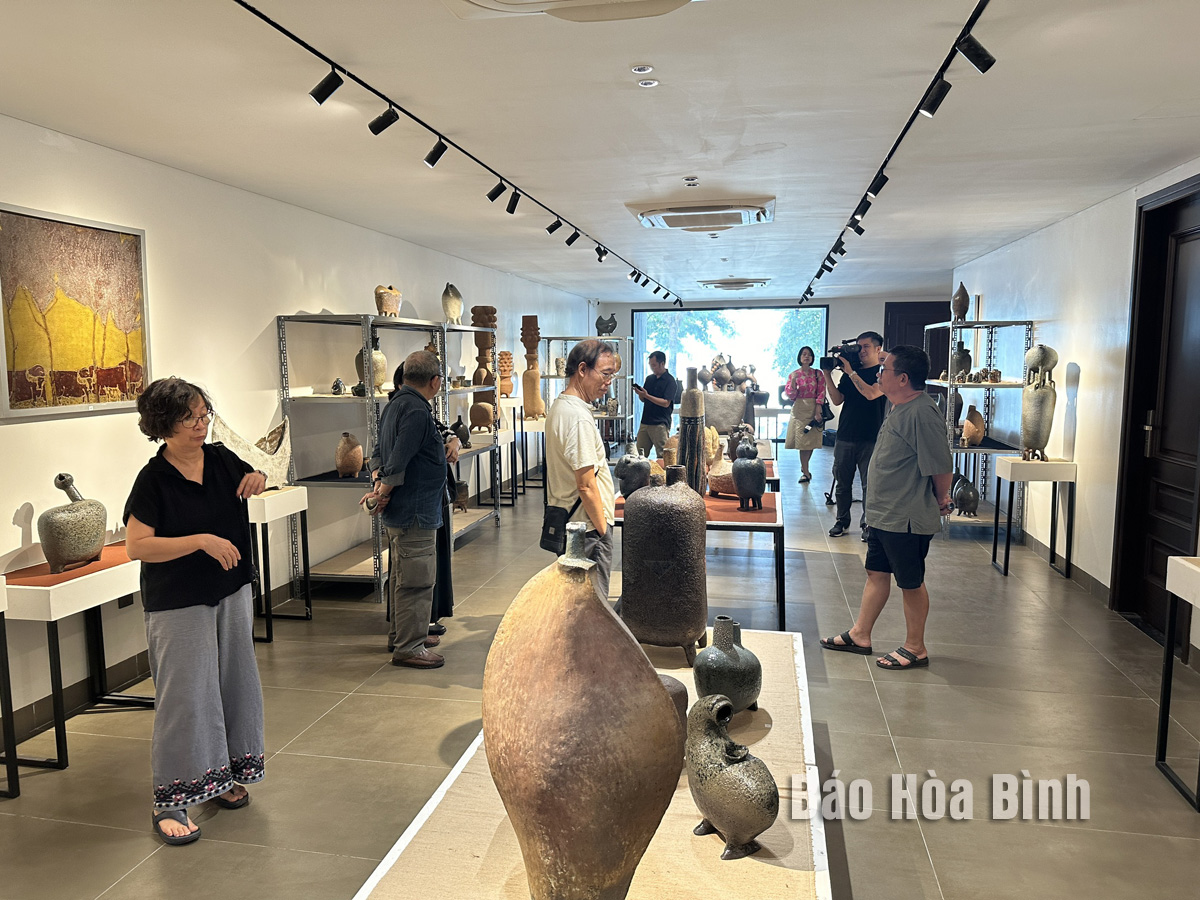
In a bid to preserve and introduce Muong culture to a wider audience across the country, in August, artist Vu Duc Hieu officially brought to the capital city pottery works inspired by the Muong ethnic community in Hoa Binh province by creating a rich cultural space at 85 Nhat Chieu street in Tay Ho district.
Over 130 Muong-inspired pottery works displayed at 85 Nhat Chieu street in Tay Ho district of Hanoi.
The special pottery line came into existence in September 2014 when Hieu chose the name of "Gom Muong (Muong pottery)” for his related workshop and ceramic works completed at the Muong Cultural Space Museum at 202 Tay Tien Street, Thai Binh ward, Hoa Binh city.
Unlike other ceramics on the market, the line does not follow any preset patterns, drawing inspiration mainly from the history, culture, members, and land of the Muong ethnic community in Hoa Binh. Remarkably, over 90% of the materials used in crafting and firing the pottery, such as clay, ash glaze additives, and other distinctive ingredients, are sourced locally, particularly from the areas surrounding the museum. Each Muong-inspired pottery piece embodies the soul and emotions of the artist, narrating stories of the Muong culture and its people.
Art researcher Vu Huy Thong remarked, from the raw materials of the earth, through the skilled hands of the artists, the pottery transcends the limits of materials, becoming a unique art form that reflects the blend of tradition and modernity as well as the local and the global traits.
Talking about his passion, Hieu shared, "As an artist, I want culture and art to develop together and use cultural history to create artistic stories. Over the past decade, we've regularly organised workshops and art festivals, both at home and abroad to introduce our Muong pottery. Beyond fostering exchanges and learning, my greatest hope is that artists will explore the local culture of the Muong people and Vietnamese culture at large".
He noted that when artists find inspiration there and produce their art, they help extend the Muong culture to communities at home and abroad.
After ten years of tireless efforts, his pottery line has made significant strides, gradually establishing a name in the Vietnamese ceramic industry. In 2014, its first pieces were showcased at an exhibition at 83 Xuan Dieu, Hanoi. In 2017, a related workshop brought together over 30 sculptors and painters passionate about ceramics from various places to create works on-site, leaving behind valuable experiences, new methods, and high-quality products.
To bring Muong-inspired pottery closer to art lovers in Hanoi, the "Mo xuong gom Muong (Opening the Muong pottery workshop)" event in August 2024 was meticulously prepared by Hieu and his colleagues, marking the 10th anniversary of the workshop’s operations and displaying more 130 selected works from various artists at the workshop over the past decade.
Phong Phu commune, Tan Lac district of Hoa Binh province, is widely regarded as the cultural heartland of the Muong ethnic group. Among its many traditional communities, Luy Ai hamlet (formerly Ai hamlet) stands out as a rare location where the customs and way of life of the Muong Bi people remain largely intact.
The Truong Kha temple festival, a distinctive cultural event held every three years in Vu Ban township, Lac Son district, returned recently with vibrant rituals and folk traditions of the Muong people. Located next to the Buoi River in the Muong Trao fields, the Truong Kha Temple is dedicated to the three Kun Dol deities, revered for teaching farming techniques, irrigation, weaving, and protecting the harvest.
The demand for spaces serving community activities of residents in various areas across Hoa Binh city has been satisfied as local cultural houses now feature modern, spacious facilities thanks to the effective implementation of Resolution No. 49/NQ-HDND issued on December 28, 2021 by the city People's Council, which approved the plan for reorganising, converting, and allocating land for the construction, repair, and expansion of cultural houses in Hoa Binh’s villages and residential areas until 2025.
At the end of May, the Hoa Binh Provincial Ethnic Arts Troupe organized a series of performances for residents in Region 2 and Region 3 communes across the province. Bringing art to ethnic communities in remote, isolated, and especially disadvantaged areas has become a meaningful activity. These are not merely artistic performances but also journeys to disseminate cultural values, enrich spiritual life, and contribute to preserving the cultural identity of ethnic minorities.



